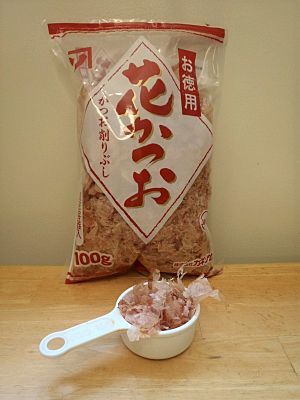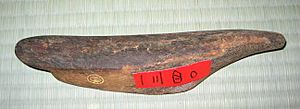Katsuobushi facts for kids
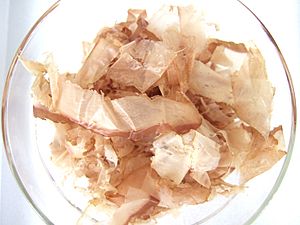
Katsuobushi shavings from a package
|
Katsuobushi (Japanese: 鰹節) is a special Japanese food. It is made from skipjack tuna, which is sometimes called bonito. To make katsuobushi, the fish is first cooked, then smoked, and finally fermented. It is also known as bonito flakes. Sometimes, katsuobushi or similar fish products are called okaka (おかか).
Thin shavings of katsuobushi are very important in Japanese cuisine. They are often used with dried kelp, called kombu. Together, they make dashi, which is a basic broth. This broth is used in many Japanese soups, like miso soup, and in different sauces.
Katsuobushi has a unique savory taste called umami. This taste comes from something called inosinic acid inside the fish. The traditional way to make katsuobushi involves a special fungus called Aspergillus glaucus. This fungus helps to remove moisture from the fish. It also helps to make the flavor even richer.
How Katsuobushi is Made
Making katsuobushi is a long process. First, the fish is prepared. Its head and insides are removed, and it is cut into large pieces called fillets. The fatty parts are trimmed off because they don't preserve well.
Next, the fillets are placed in a basket. They are then gently cooked in hot water for about an hour or more. The cooking time depends on how big the fish pieces are.
After cooking, the rib bones are taken out. Then, the fillets are smoked for up to a month. Woods like oak or castanopsis are used for smoking. The fish is smoked for 5-6 hours at a time. Then, it rests for a day to let moisture come to the surface. This smoking and resting cycle is repeated many times, usually 12 to 15 times. Any sticky tar from the smoke is cleaned off the surface. At this point, the fish pieces are called aragatsuo (荒節). They are often shaved and sold in stores as katsuo-kezuri-bushi (鰹削り節) or hanakatsuo. These are good, but they are not true katsuobushi yet.
The final step is fermentation using mold. The fillets are sprayed with a special mold called Aspergillus glaucus. They are left in a special room for two weeks. This mold helps to ferment the fish and remove even more moisture.
The mold is regularly scraped off. The fish is also sun-dried more to make it harder and drier. Eventually, the fillet looks like a piece of wood. It loses more than 80% of its original weight. Only fish treated this way can be called katsuobushi. If the mold growth and sun-drying process is repeated at least twice, it's called karebushi (枯節), meaning "dried fillet." If it's done more than three times, it's called honkarebushi (本枯節), or "true dried fillet." These very dry pieces make a metallic sound when tapped. Inside, they are a beautiful deep ruby red color. Sometimes, high-quality honkarebushi is dried for over two years.
In the old Edo era, some katsuobushi went through an extra step. This was called the tebiyama style (手火山式, tebiyama-shiki) process. After boiling and deboning, the fish were steamed over a wood fire for a few hours. They were rotated to get even smoke. This made the flavor stronger and helped the fish last longer. Today, only a few factories still use this special method.
Shaving Katsuobushi
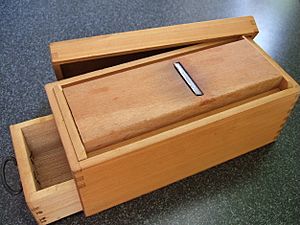
In the past, people would shave chunks of katsuobushi at home. They used a tool similar to a wood plane, called a katsuobushi kezuriki.
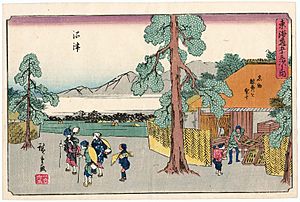
Today, you can usually buy katsuobushi in bags. It comes as small, pink-brown shavings. There are different thicknesses. Thinner shavings, called hanakatsuo (花鰹), are used to add flavor and as a topping for many Japanese dishes. Thicker shavings, called kezurikatsuo (削り鰹), are mostly used to make the popular dashi broth.
What Katsuobushi is Used For
Besides making dashi, katsuobushi has many other popular uses:
- Okaka: This is finely chopped katsuobushi mixed with soy sauce.
- As a seasoning for cold tofu dishes, called hiyayakko. It's often served with grated ginger and Welsh onion (a type of spring onion).
- Sprinkled with sesame seeds and chopped nori on top of cold soba noodles (zarusoba).
- As a topping on popular Japanese street foods like takoyaki (octopus balls) and okonomiyaki (savory pancakes).
- As a seasoning on preserved eggs, along with sesame oil and soy sauce.
- It's even sold as a high-protein treat for cats in pet stores.
- As a topping for ramen noodles, often mixed with salt.
See also
 In Spanish: Katsuobushi para niños
In Spanish: Katsuobushi para niños


